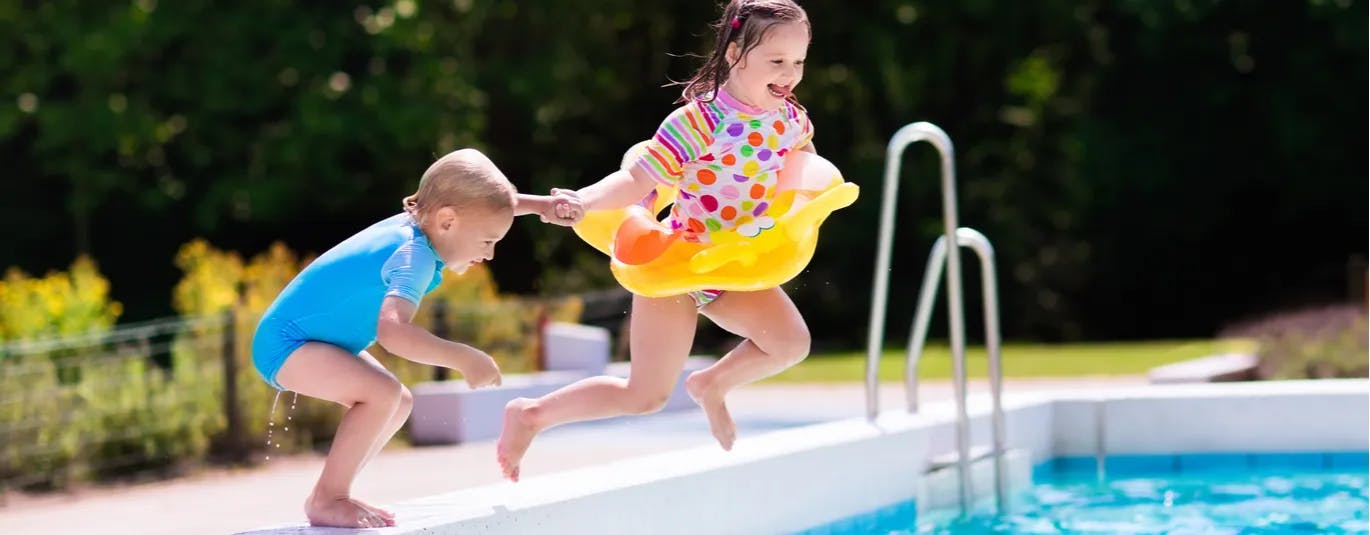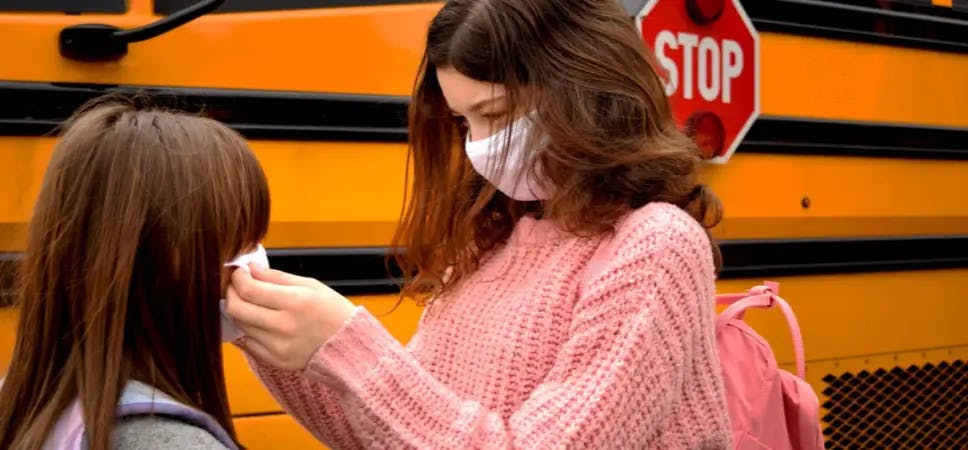
A child at my son’s school tragically died this spring. He slipped while out fishing at a lake and drowned. He was only nine. I didn’t know this child personally, but I mourned his loss along with the rest of the school community. He had a big, beautiful smile, and those who knew him said he had an even bigger personality. My heart broke for his mother.
No parent, family or community should have to endure the loss of a child from drowning. Unfortunately, drowning is the leading cause of injury death for children aged 1 to 14, according to the CDC. Three children in our country die every day as a result of drowning.
Those kinds of stats make me want to keep my kids land-locked. But, like many children, they love water and are drawn to it. Our community pool is closed this summer, so we bought a small (and some might say “tacky”) above-ground pool. My son already knew how to swim, but my daughter has gone from wearing floaties to being a little mermaid in just weeks.
How do I keep them safe in our little pool (or the lake, the ocean, any body of water)? What if I got too engrossed in another depressing news article about COVID, or just came inside for 5 minutes to do laundry, and something happened?
How does anyone keep their child safe this summer, when we’re all desperate for a little fun, and maybe a bit (or a lot) more distracted and stressed than we were in pre-COVID times?
I wrote a post a few years ago about drowning and learned some good tips then. I also recently talked to Cameron Corder, the Executive Director for the Cleveland County YMCA. The YMCA has been a critical part of North Carolina communities for decades and has taught so many of our children to swim. Here’s our conversation.
FIRST OFF, CAN YOU GIVE ME A FEW RECENT STATS ON YOUTH DROWNING, PARTICULARLY IN NC?
Nationwide, and in North Carolina, the drownings statistics are sobering:
Nearly half of the 2,077 drownings in 2018 nationwide happened between May and August.
Between July 2008 and July 2018, there were 725 drownings in NC, and 66% of them were teens and younger.
North Carolina ranks 6th highest in the nation for drowning deaths during the 2008-2018 period.
African American and Hispanic people account for more than three times as many drowning incidents.
Data shows that taking part in swim lessons and water safety classes can cut the risk of drowning by up to 88%.
DO YOU HAVE EXTRA CONCERNS FOR KIDS THIS SUMMER, AS MANY CAMPS ARE CLOSED, PARENTS ARE WORKING, AND KIDS MAY BE LEFT TO THEIR OWN DEVICES A BIT MORE? HOW DO WE KEEP OUR NATION’S YOUTH SAFE THIS SUMMER?
Many Y camps are making swimming a part of the daily camper experience with an emphasis on water safety instruction and supervision.
Data shows that a large number of childhood drownings actually take place while a child is in an adult’s care (60%). Often times, groups of adults may think that another parent is watching the kids in the water, when they really aren’t. They may also think they would be able to hear a child struggling in the water and be able to respond. In reality, drowning is a silent event.
Adults should take turns and be intentional about watching children near on in the water. Parents of non-swimmers should always keep their children at arm’s reach while in the water. A child’s safety should never be left unattended. Books, naps and socializing should be reserved for when children are on dry land.
Additional information about at-home drowning risks:
In-ground swimming pools that are not fenced off are 60% more likely to be involved in drownings than those with four-sided isolation fencing.
Drownings and near-drownings tend to occur on the weekend (40%) and between the months of May and August (62%).
69% of incidents occurred while one or both parents were responsible for supervision.
65% were in the pool owned by the child’s family, 22% at a relative’s, and 11% at a neighbor’s home.
77% of drowning victims had been seen 5 minutes or less before being missed.
46% of drowning victims were last seen in the house
Source: USA SAFE KIDS, CSPC
WHAT ARE SOME GENERAL TIPS FOR KIDS BEING AROUND WATER, WHETHER AT A POOL, LAKE, OR THE BEACH?
Before letting your children hit the water this summer, remember these few tips to ensure it’s an enjoyable and safe experience.
Never swim alone.
Teach your children that they should only swim in locations where a lifeguard is on duty.
Supervise your children whenever they’re in water.
Whether it’s bath time or taking a dip in a pool or lake, make sure your children are within arm’s reach at all times.
Don’t engage in breath holding activities.
Children shouldn’t hold their breath for a prolonged amount of time while swimming. This can cause drowning and has several other severe physical side-effects.
Wear a Life Jacket.
Inexperienced or non-swimmers should wear a Coast Guard-approved life jacket.
Don’t jump in the water to save a friend who is struggling in deep water.
If a child finds their friend in deep water unexpectedly, their natural reaction may be to jump in the water to try to save them. Even if a child is a great swimmer, a panicked person will overpower them, pulling them underwater with them. The Y’s water safety programs teach the “reach, throw, don’t go” concept. This refers to using a long object to reach for them and pull them to safety. By using this technique, children can help their friend without compromising their own safety.
Enroll your children in water safety or swim lessons.
Just like teaching your children to look both ways before they cross the street, participating in formal water safety lessons teaches them an important life skill. The Y’s water safety and swim lesson programs teach children fundamental water safety skills and what to do if they find themselves in water unexpectedly.
I’M AWARE THAT BLUE CROSS NC HAS INVESTED AGAIN IN YOUR SWIM PROGRAMS. COULD YOU TELL ME A BIT ABOUT HOW YOU GUYS ARE USING THAT MONEY?
One of the challenges in our county and many other rural counties across the state is we are in a dire need for Life Guards. We are using a portion of the funds to recruit and pay for the certifications for new guards.
We have partnered with the school systems in Cleveland and Rutherford Counties to bring 2nd graders through the Y’s Water Safety/Learn to Swim programs. Of course, this spring we were unable to offer them because of the pandemic. We are working on plans to work with the schools and other groups to implement critical swim programs for at risk groups as our pools open.
We all want to have some fun this summer. We all want to cool off from the heat. We all deserve some time to relax and try and take a break from the pandemic and everything that’s going on.
But please, be extra safe and cautious when letting your children play in water. I promise to do the same.
RELATED: , , A Mom’s Perspective On Managing A Pandemic Back-To-School Season, Mobile Clinic Provides Health Care to Kids in Need, 5 Places To Find Spring In North Carolina
Ready to get started?
Related Articles

100 Screen-Free Ways To Keep Kids Active This Summer
In the United States, the percentage of children and adolescents with obesity has more than tripled since the 1970s (CDC). And with sports and summer camps on hold because of the coronavirus, our kids may be feeling especially stir crazy.
If we can help kids play and be more active, it will benefit them physically and emotionally.
Michelle Rogers

7 Tips: Helping Children Overcome Anxieties About Returning To School
Many of us eagerly anticipate the moment when we can gather in groups again. We crave that vital sense of connection to our loved ones, to our peers and to our community. But that doesn’t mean reintegrating into social settings will be easy. It can be especially scary for children.
My son’s reluctance is not an isolated tale. Incidents of children refusing to return to group settings are on the rise. In particular, many parents have noted that their children with anxiety disorders were happier and more comfortable at home. While the pandemic has left most children feeling more stressed, we know that some children with social anxiety or OCD have actually been happier in social isolation.
Blue Cross NC By Nora Dennis

A Mom's Perspective On Managing A Pandemic Back-To-School Season
I was glad for my face mask to hide my emotions as a teacher checked their temperatures and they headed up the stairs to their school building – my fifth grade son with a protective arm around his kindergartner sister, a purple Post-It note with her name and her teacher’s name on her chest.
She’d never been inside the building as a student before.
Maggie Brown via Blue Cross NC